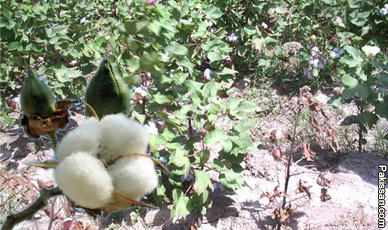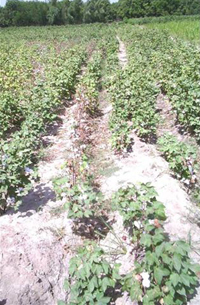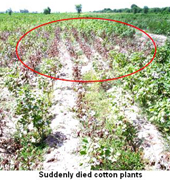|
Main Page
|
![]() |
Sudden death of cotton plant
results monetary losses
 Cotton
is one of the most important fiber and cash crop of the
world. Pakistan is the 3rd largest exporter of raw
cotton and a leading exporter of yarn in the world;
contributes nearly 10 percent in the agriculture GDP and
is a source of 60 percent foreign exchange earnings. The
value addition through cotton is 8.2 percent in
agriculture and 2 percent in the GDP. Sindh and Punjab
are the ancient homes of cultivated cotton. It is
considered white gold of Pakistan. The area under
cultivation and production is about 3192 thousand
hectares and 14265 thousand bales, respectively with 760
kg/hectare yield. The crop has maximum area in Punjab
followed by Sindh and very negligible in NWFP. The yield
per hectare of seed cotton in Punjab is more to that of
Sindh province. Cotton
is one of the most important fiber and cash crop of the
world. Pakistan is the 3rd largest exporter of raw
cotton and a leading exporter of yarn in the world;
contributes nearly 10 percent in the agriculture GDP and
is a source of 60 percent foreign exchange earnings. The
value addition through cotton is 8.2 percent in
agriculture and 2 percent in the GDP. Sindh and Punjab
are the ancient homes of cultivated cotton. It is
considered white gold of Pakistan. The area under
cultivation and production is about 3192 thousand
hectares and 14265 thousand bales, respectively with 760
kg/hectare yield. The crop has maximum area in Punjab
followed by Sindh and very negligible in NWFP. The yield
per hectare of seed cotton in Punjab is more to that of
Sindh province.
Cotton crop is totally useful for human beings and
animals from seed to waste, basically is a natural fiber
that finds use in many products, range from clothing to
home furnishing and producing medical products; as a
result, it is always in demand though its use is subject
to the strengths and weaknesses of the overall economy.
Cotton feeds 1035 ginners and about 5000 oil expelling
units, which produce 4.00 million tons edible oils. In
such a way, cotton brings cash return to farmers, supply
raw material to textile industry and provides employment
to thousands workers, both in rural and urban areas.
About two third of the harvested crop is composed of the
seed which is crushed to separate its three products
oil, meal and hull. Cotton seed oil is a common
component of many food items, used primarily as cooking
oil. The oil is used extensively in the preparation of
snacks food and crackers, cookies and chips. The meal
and hull are used as feed for live stock, poultry and
fish. Cotton waste, meal and hull also used as
fertilizer for improving soil fertility. Cotton waste is
also multiuse product used for mulching in crops,
substrate for artificial cultivation of edible and
medicinal mushrooms.
However, the productivity rate of cotton for Pakistan
did not depart significantly from the world average
(1,576 kg/ha) over the period, because of many reasons,
including diseases, caused by fungi, bacteria,
nematodes, viruses and physiological disorders. Lyda and
Watkins (2001, www.apsnet.org) listed 3 bacterial, 17
fungal, 4 plant parasitic nematodes, 10 viral and 2
phytoplasmal and spiroplasmal diseases in world. The
work carried out so far in Pakistan shows that seedling
rot or wilt, root rot, boll rot, anthracnose, different
types of leaf spot diseases, premature opening of bolls
(Tirak), stunting and reduction in size of leaves, some
nematode species, bacterial blight (angular leaf spot
and boll rot), leaf curl and stenosis of cotton, found
causing damage to the crop. These diseases are injurious
in some areas, in some years and on some plant parts.
The magnitude of disease damage depends up on the
environment and cultivar. In spite of all, cotton wilt
disease is the most dangerous, causes sudden death of
plants and results monetary losses after infection;
therefore in severely affected areas it may cause whole
fields to be ploughed out.
Several species of Fusarium and Verticillium fungi
causes wilt. Both the fungi differ from one another,
but cause very similar symptoms. The only reliable
method for separating and identifying these diseases
is taxonomy of causal fungi, both can be readily
isolated and cultured from the diseased plant
portions. Both the fungal wilts thrive with high
nitrogen fertilizer, excessive soil moisture, thin
stands and deep cultivation. Both the fungi survive
for long periods (for at least a decade) in soil on
organic matter and even on non-host plants. However,
some of the differential general characteristics
between both the wilt fungi may also help in
identification and control.
 Fusarium
wilt develops well in acid soils, is more prevalent
in sandy soil, causes more injury when the nematodes
injure the roots, can be transmitted internally in
seed and prefers hotter soil than Verticillium.
Whereas, Verticillium wilt thrives in alkaline soil;
is more prevalent in heavy soils, does not require
injury for infection, can not be transmitted
internally in seed and prefers cooler soil than
Fusarium. Fusarium
wilt develops well in acid soils, is more prevalent
in sandy soil, causes more injury when the nematodes
injure the roots, can be transmitted internally in
seed and prefers hotter soil than Verticillium.
Whereas, Verticillium wilt thrives in alkaline soil;
is more prevalent in heavy soils, does not require
injury for infection, can not be transmitted
internally in seed and prefers cooler soil than
Fusarium.
The wilts start appearance at seedling in case of
early attack and/or may also occur at any plant
growth stage. Areas of reduced or patchy plant stand
can be seen in affected fields, usually spreading in
the direction of irrigation flows. Symptoms include
seed and seedling rot, wilting, death of seedling
and adult plants, accompanied by vascular browning.
Initially, vein clearing and leaves show a distinct
loss of turgor and yellowing occurs starting at the
leaf margin between the main veins, sometimes
referred as leaf epinasty, followed by stunting. The
stunted plants may fruit early. The yellowing
progresses inward and is followed by necrosis hence
defoliation occurs starting at the bottom of the
plant, and consecutively towards the top, results
progressive wilting of leaves and stem, defoliation
and finally death of the plant (partially or
wholly), some attempted regrowth. The diseased
plants are pulled out easily, due to the loss of
rigidity. Brown, red or yellow rings of discolored
tissue observed in case of cutting the stem in
crossways, mostly close to the base and plant death
occur in severe cases. Fusarium wilt is a solid dark
brown ring compacted with healthy white stems around
the outer portion of the stem and that the infected
areas observed irregular in shape and size.
Water-conducting stem tissues turn brown and become
inactive, resulting in wilted foliage. Leaves turn
yellow between veins and eventually shed as plants
die to leave bare stems. Once the fungus has
colonized the plant the diagnosis is confirmed by
splitting the stem to reveal dark brown, vascular
discoloration and streaking characteristic of wilt,
most likely causes the death of the host. The wilt
diseases mostly spread in patches, but entire field
may also be affected in severe conditions. Certain
strains of the causal fungus only cause symptoms
when plants are also infected with the root knot
nematode. In those cases, galls are usually
prevalent on lateral roots. Some formae speciales
are not primarily vascular pathogens but Fusarium
spp. may also cause foot and root rot or bulb rot in
cotton.
Cotton wilt causing both pathogenic fungi (Fusarium
and Verticillium spp.) are seed-borne, may carry
over for long-distance, spread from year to year by
sowing infected seed; also move from field to field,
farm to farm and region to region, whenever very
small quantities of infested soil is transported
through boots, farm equipments, vehicles, in water
(irrigation and overland flows), in flood irrigation
and also in infected plant material, including seed
etc. The fungi sustains on the outer surface of
roots of many crops and weeds and survives
indefinitely in soil for at least a decade, even in
the absence of cotton plants. The diseased plant
debris lying in the field or in the storage space
also helps both the fungi to remain alive. The
cotton husks, used as cattle feed are also
identified as a potential source for spread of wilt.
The scientists also reported very broad host range
of both the wilt causing fungi, at the species
level. More than 120 different formae speciales have
been identified based on specificity to host species
belonging to a wide range of plant families.
 Prevention
is better than cure, because control of wilt
diseases is very difficult, chemical control is very
costly and even is impossible to recover heavily
infected, shriveled and damaged plants. However,
cultivation of resistant variety is only the most
easy, economical and safe method. Growers are
advised to plant improved immune or resistant
varieties, because these are equal to the
susceptible varieties in yield, adaptation and other
cultural characteristics and field practices; since
new races of the fungi may develop and attack on
these. However, it is necessary that growers must
keep in touch with the latest information on
resistant varieties and control measures. The
following preventive measures also help to minimize
risk of damage. Prevention
is better than cure, because control of wilt
diseases is very difficult, chemical control is very
costly and even is impossible to recover heavily
infected, shriveled and damaged plants. However,
cultivation of resistant variety is only the most
easy, economical and safe method. Growers are
advised to plant improved immune or resistant
varieties, because these are equal to the
susceptible varieties in yield, adaptation and other
cultural characteristics and field practices; since
new races of the fungi may develop and attack on
these. However, it is necessary that growers must
keep in touch with the latest information on
resistant varieties and control measures. The
following preventive measures also help to minimize
risk of damage.
• Crop rotation with non host crop is preferably
recommended, because lower disease intensity has
been reported in case to avoid cultivation of
susceptible varieties/cultivars in the diseased area
at least for three years.
• Clean cultivation by removing infested plant
materials after harvesting through deep and
repeatedly tillage operations help to destroy
infected plant parts from field.
• Good drainage improves soil conditions which help
to minimize the disease incidence.
• Use of disease free and certified seed or seed
treatment with suitable seed dressing fungicides
before sowing is also recommended.
• In some cases, late and deep sowing reduces
disease incidence.
• Mixed cropping with non host crops also help to
check the disease.
• 5-6 weeks mulching with colorless plastic is
recommended for soil solarization and straw mulch
help to maintain temperature for reducing the fungal
population in crop field.
• Uprooting and burning of diseased plants and weeds
help to minimize further spread of the problem.
• Proper irrigation and balanced fertilizer
application help to grow healthy plants with the aim
of more resistance against wilt and other diseases.
• Avoid storage of plant waste material and even
storage in the field, otherwise sweeping the waste
material from storage space and burning or burying
all plant debris must be ensured.
Courtesy: M. Mithal Jiskani and Gul Bhar Poussio
Department of Plant Pathology, Sindh Agriculture
University Tandojam |
|
Pakissan.com;
|
|
|